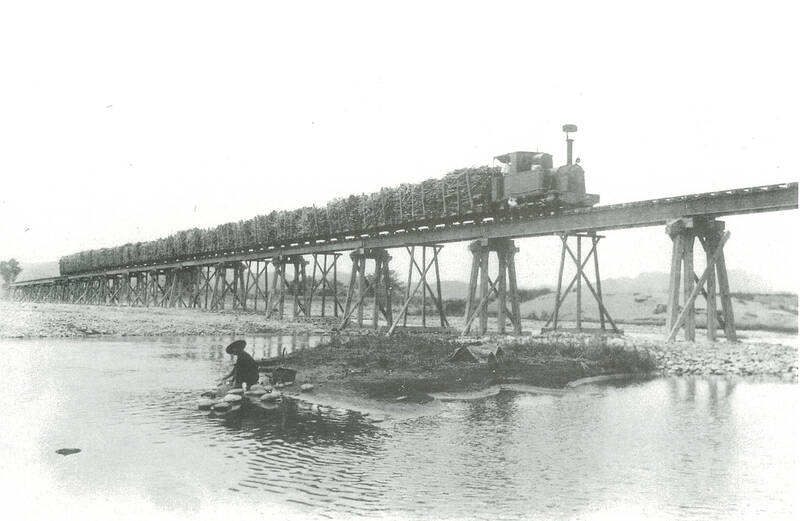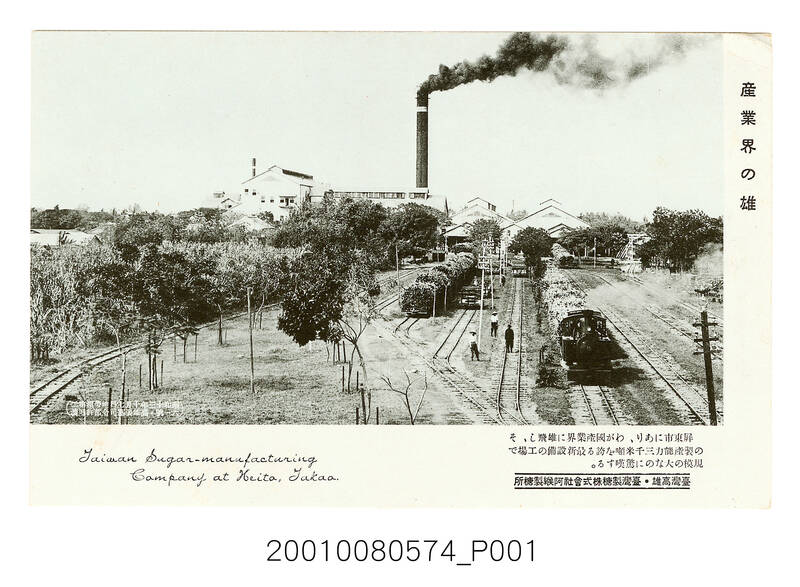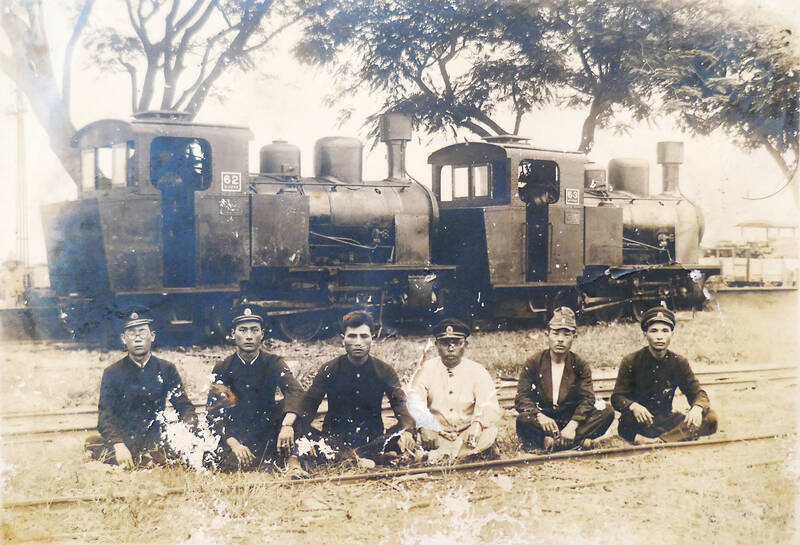Sept. 9 to Sept. 15
The upgrading of sugarcane processing equipment at Ciaozaitou Sugar Factory (橋仔頭) in 1904 had an unintended but long-lasting impact on Taiwan’s transportation and rural development.
The newly imported press machine more than doubled production, leading to an expansion of the factory’s fields beyond what its original handcarts and oxcarts could handle. In 1905, factory manager Tejiro Yamamoto headed to Hawaii to observe how sugarcane transportation was handled there. They had trouble finding something suitable for Taiwan until they discovered a 762mm-gauge “miniature” railroad at a small refinery in the island of Maui.

Photo courtesy of Taiwan Cultural Memory Bank
On Sept. 15, 1907, Taiwan’s first ‘sugar railway’ (糖業鐵路) was officially inaugurated at the Ciaozaitou plant, which was later renamed Ciaotou (橋頭), and the system was quickly adopted by other companies and factories.
Starting from 1909, some routes began offering freight and passenger services; they became known as “business lines” as opposed to the industry-only lines. Since most factories were in relatively remote rural areas, this move greatly improved transportation and sped up development in areas not covered by the state-run Western Trunk Line that ran from north to south.
By the end of the Japanese era, nearly 3,000km of sugar railroads covered the central and south parts of western Taiwan, with more than 600km of it being business lines. They linked countless tiny communities to larger cities, changing the rural landscape forever.

Photo courtesy of Open museum
BIRTH OF THE ‘HALF CAR’
The Taiwan Sugar Corporation (unrelated to the modern company) was established in Tokyo in 1900 as part of the government-general’s plan to eventually make the colony financially independent from the motherland of Japan. It was backed by Mitsui & Co, which would set up numerous other business interests in Taiwan.
The company first sent staff to survey Taiwan, and they decided on the Ciaozaitou area in today’s Kaohsiung as the site of their first factory. Ciaozaitou Sugar Factory was the nation’s first modern refinery, and it remained in use until 1999.

Photo courtesy of Taiwan Cultural Memory Bank
The factory then applied to the government in 1901 to establish Ciaozaitou Station on the Western Trunk Line between Tainan and Kaohsiung so that they could transport goods to Kaohsiung’s harbor.
Due to limited efficiency, a traditional sugarcane processing plant could only support about 14.5 hectares of sugarcane fields, according to a 2007 publication by the modern Taiwan Sugar Corporation celebrating the sugar railway’s 100th anniversary. The Ciaozaitou factory was far more efficient, and Yamamoto built light rail tracks for the pushcarts and oxcarts to run on. This option remained viable until the 1904 upgrade.
It was imperative to transport the harvested sugarcane to the refinery within a certain time period to ensure optimal quantity and quality. With much larger fields, the factory needed faster transportation. Upon arrival in Hawaii, Yamamoto and his staff found that refineries there mostly used 914mm-gauge rails — which were not that different from the Western Trunk Line’s 1067mm-gauge rails, and did not fit their needs.
The discovery of the miniature railway in Maui was a revelation, however, and Yamamoto immediately applied for permission to import the system to Taiwan. The factory first built a few kilometers of the 762mm-gauge rail and tested it by having water buffaloes drag the new carts along the tracks, and the results were favorable. They then transitioned to steam.
These diminutive trains were nicknamed “wufenche” (五分車), literally translating to half-cars, referring either to them being about half the size of the 1,435mm standard gauge railway, or that they ran at about half the speed of regular trains.
OPEN FOR BUSINESS
In 1908, the factories requested the government for permission to open up certain routes of the sugar railroad to freight and passenger service. Guidelines for private commercial rails were promulgated the following year, and in May 1909 Ensuiko Sugar Refining Co became the first to accept passengers on the Sinying (新營) to Yanshui (鹽水) line in today’s Tainan County.
There were a number of Japanese, Taiwanese and Western sugar companies in Taiwan at first, but due to government policy that favored Japanese businesses, most of them were eventually pushed out or bought out. By 1917, the “big five” of Taiwan, Meiji, Ensuiko, Toyo and Dainippon dominated and produced about 75 percent of Taiwan’s sugar, which accounted for about 80 percent of the colony’s industrial revenue.
By this time, there were about 1,600km of sugar railroads, with about 400km offering commercial services. The Ciwei Line (旗尾), built by the Takasago Sugar Corporation in 1910, became the longest business line with the most stops. The initial line ran for 10 stops between the Western Trunk Line’s Jioucyutang (九曲堂) station and the Qiwei Sugar Factory further inland. This route drastically cut down traveling time to today’s Qishan District (旗山) in Kaohsiung, accelerating development in the area.
Takasago was acquired by Ensuiko shortly after the railway’s completion. At first, the Ciwei Line carried about 70,000 passengers per year, but after improving the carriages, adding stops and increasing train frequencies, this number had grown to 318,532 by 1929. By the 1930s, the 40km line extended further east to Meinong (美濃) and boasted an average of one stop every two kilometers. In 1941, it carried 713,390 passengers.
The business lines also boosted tourism. In 1911, Dainippon’s route from Chiayi County’s Beigang (北港) to Yuniln County’s Huwei (虎尾) line was inaugurated, and it was used by scores of pilgrims heading to the famed Chaotian Temple (朝天宮) in Beigang. In 1920, more than 10,000 people accompanied Siluo’s (西螺) Fusing Temple (福興宮) on their journey to offer incense at Chaotian Temple.
An Academia Sinica document states that the network looked like a tree, with the sugar railways branching east and west from the Western Trunk line. They did not connect to each other, however, relying on the Western Trunk Line to transport their goods to Kaohsiung Harbor.
Although many rail lines were damaged by US air strikes during World War II, they continued to be used and expanded under the Chinese Nationalist Party (KMT) after 1945, providing vital services until their rapid decline in the 1970s.
That story will be covered in next week’s feature.
Taiwan in Time, a column about Taiwan’s history that is published every Sunday, spotlights important or interesting events around the nation that either have anniversaries this week or are tied to current events.

April 14 to April 20 In March 1947, Sising Katadrepan urged the government to drop the “high mountain people” (高山族) designation for Indigenous Taiwanese and refer to them as “Taiwan people” (台灣族). He considered the term derogatory, arguing that it made them sound like animals. The Taiwan Provincial Government agreed to stop using the term, stating that Indigenous Taiwanese suffered all sorts of discrimination and oppression under the Japanese and were forced to live in the mountains as outsiders to society. Now, under the new regime, they would be seen as equals, thus they should be henceforth

Last week, the the National Immigration Agency (NIA) told the legislature that more than 10,000 naturalized Taiwanese citizens from the People’s Republic of China (PRC) risked having their citizenship revoked if they failed to provide proof that they had renounced their Chinese household registration within the next three months. Renunciation is required under the Act Governing Relations Between the People of the Taiwan Area and the Mainland Area (臺灣地區與大陸地區人民關係條例), as amended in 2004, though it was only a legal requirement after 2000. Prior to that, it had been only an administrative requirement since the Nationality Act (國籍法) was established in

With over 80 works on display, this is Louise Bourgeois’ first solo show in Taiwan. Visitors are invited to traverse her world of love and hate, vengeance and acceptance, trauma and reconciliation. Dominating the entrance, the nine-foot-tall Crouching Spider (2003) greets visitors. The creature looms behind the glass facade, symbolic protector and gatekeeper to the intimate journey ahead. Bourgeois, best known for her giant spider sculptures, is one of the most influential artist of the twentieth century. Blending vulnerability and defiance through themes of sexuality, trauma and identity, her work reshaped the landscape of contemporary art with fearless honesty. “People are influenced by

The remains of this Japanese-era trail designed to protect the camphor industry make for a scenic day-hike, a fascinating overnight hike or a challenging multi-day adventure Maolin District (茂林) in Kaohsiung is well known for beautiful roadside scenery, waterfalls, the annual butterfly migration and indigenous culture. A lesser known but worthwhile destination here lies along the very top of the valley: the Liugui Security Path (六龜警備道). This relic of the Japanese era once isolated the Maolin valley from the outside world but now serves to draw tourists in. The path originally ran for about 50km, but not all of this trail is still easily walkable. The nicest section for a simple day hike is the heavily trafficked southern section above Maolin and Wanshan (萬山) villages. Remains of